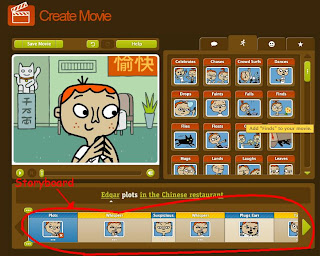 Movie making or animation software can often become too complex and confusing. This website is catered for children using simple action/speech inserts. When one inserts an action/speech, it becomes a scene on the storyboard below. By adding more action/speech inserts the students create an animation.
Movie making or animation software can often become too complex and confusing. This website is catered for children using simple action/speech inserts. When one inserts an action/speech, it becomes a scene on the storyboard below. By adding more action/speech inserts the students create an animation. This website has a great concept. People can register and start making thier own movies. The fantastic thing about this website is that there is no voice recording, but the characters can speak. Simply by typing what you want them to say, the characters say it with very close lip movements.
This website has a great concept. People can register and start making thier own movies. The fantastic thing about this website is that there is no voice recording, but the characters can speak. Simply by typing what you want them to say, the characters say it with very close lip movements.While it is a great concept, I would not use it in the classroom because the advertisments on the web page (depicted to the right "the cubicle") also show other titles not suitable for children. People who register for this site must also be over 13. See below.
The third website we looked at was a how-to-guide for creating animation. It is called Roller Mache. (www.abc.net.au/rollercoaster/rollermache)
In my classroom I would like to integrate animation creation. While it may not be something that everyone enjoys, one or two students may find it extremely interesting and persue it as a hobby and maybe even a future one day. In my classroom I would like to expose students to different professions and disciplines so that they can start to have some kind of direction in their future.
This website gives a how-to-guide on creating story boards, characters, and then the animation itself. I would say this website is for teachers rather than students. Teachers can get detailed information on how to create an animation, and then have the class or small groups make one.
There is also a gallery on the website. Students can upload their work.
The next website is called Reasonably Clever. (http://www.reasonablyclever.com/)
This website allows students to create their own lego characters and put them into comic strips. This website has a child-safe section.
The last website looked at is called Zip Tales. (http://www.ziptales.com.au/)

The view of "what literacy is" has changed over time however some teachers are still finding it difficult to depart from the traditional view of literacy: basic reading and writing. Anyone who goes into the classroom and practises this kind of literacy is doing a dis-service to their students.
Geoff Bull and Michele Anstey published an article in Practically Primary, Volume 12, number 3, October 2007. The article is called "Exploring visual literacies through a range of texts." This article explores the numerous encounters we have with literacy during breakfast time. Literacy, Bull and Anstey argue, pertains to the human semiotic system: our sign reading systems. So that does not just jnclude simple linguistic signs, but also visual, oral, auditorial, gestural, and spatial.
Students should be exposed to a variety of literary forms: books, videos, plays, animations, music, newspapaer, comic strips, advertisments, and more.
Visual learning is something I plan to implement into my classroom.











